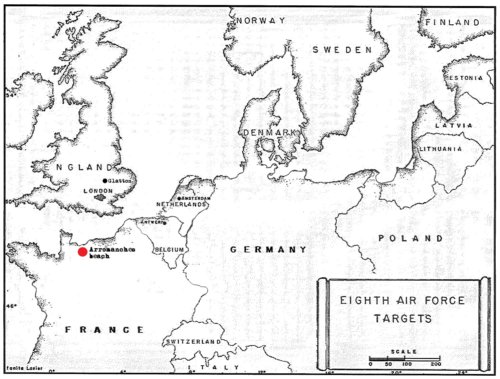TARGET: DEFENSIVE POSITION
ARROMANCHES BEACH, FRANCE
6 JUNE, 1944
INVASION DAY

At 0100, Colonel Luper entered the briefing room. The command, “Attention” was quickly followed by, “At ease”. Col. Luper walked to the front of the briefing room and stood before the huge map of Europe. “Gentlemen”, he said, “This is it.” He continued, “This is what we have all been waiting for. I need not tell you how much depends on today’s operation. Every resource in our possession must be put to use to make this mission Successful It must be successful.”
The various briefing officers then took over and for more than thirty minutes, details of the mission were explained. Nothing was omitted; nothing was left to chance. Crews were also advised only boats heading towards the United Kingdom would pick up ditched crews.
Preparation for this day had been carried out with the utmost secrecy and no hint had reached the crewmen. Nevertheless, there had been many indications the long awaited day was at hand. Additional guards had been posted. Passes had been cancelled. Ground crews worked with a sense of urgency to service the ships. The lead crews were called for pre-briefing at 1900 hours on 5 June. Thus, when crews assembled in the early morning hours of 6 June, few had to be told today was the day.
The 457th was assigned two defense positions on the Arromanches Beach that were to be bombed ten minutes before the first assault wave of the British Second Army hit the beaches. Twenty-four craft, the “First Force”, would attack a defensive position consisting of three pill boxes and three shelters on the beach just north of Creully, while eighteen craft, the “Third Force”, would attack a defended locality at Anselles-Sur-Mer, three miles west. Both targets were on the Arromanches Beach between Bayeux and Caen. Zero hour was 0725 hours.
The “First Force”, led by Col. Luper with Lt. Charles D. Brannan as pilot, began taking off at 0430 hours, followed by the “Third Force”, at 0450 hours, led by Major Fred A. Spencer, with Captain Russell M. Selwyn as pilot. Assembly was accomplished as dawn broke and the English Coast was crossed at 0632 hours. At mid-channel the cloud cover was ten-tenths. Looking out in front through a hole in the clouds and under the overcast, one could see some of the thousands of water craft on their way to the invasion.
The “First Force” dropped its bombs at 0700 hours. The “Third Force” dropped at 0710 hours. At the same time the primary targets were being shelled by warships and hit by dive bombers. The whole invasion coast was obscured by clouds and it was not until the formation approached the English Coast that the many invasion craft could be seen again. No enemy fighters or flak were encountered. All planes returned to the Base and crews stood by for a second mission, but none was ordered.
The crews finished the day’s work hope full their efforts had aided a Great Crusade. The Eighth put up a total of 2512 bombers during the day. Only five planes were lost.
